Pena Palace
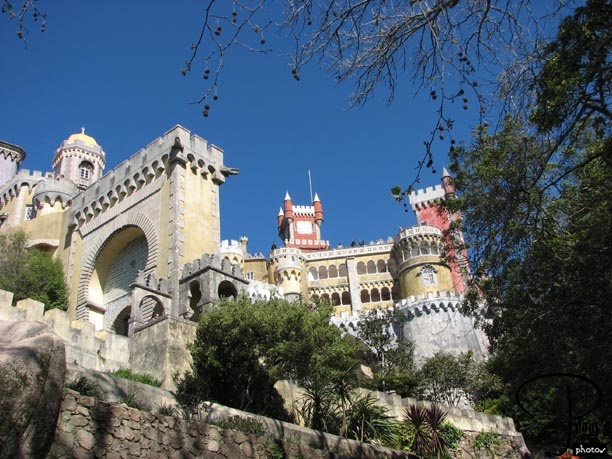
This photo is of Pena Palace in Sintra, Portugal, the destination of my first full day in Portugal.

Pena Palace
Hotel Mundial
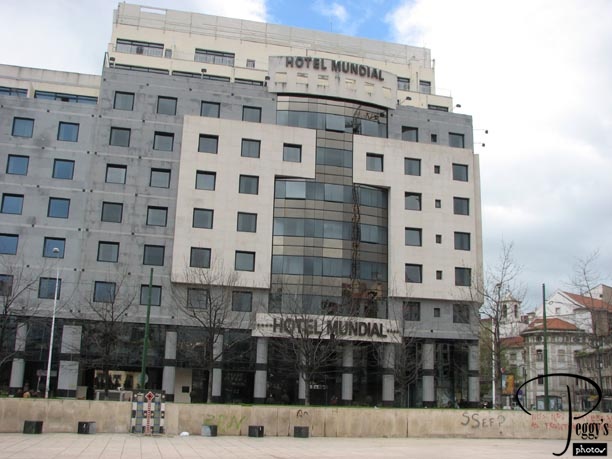
My hotel in Lisbon. I left Los Angeles aboard United Airlines at 6:30 p.m. on March 19 and arrived in Frankfurt, Germany, at 12:30 p.m. on March 20. Since we went on daylight savings time early, there was only an 8–hour time difference between Frankfurt and L.A. However, that didn’t make me less tired during my 9–hour layover in Frankfurt––this really was the hardest part of my trip: trying to stay awake in Frankfurt until my plane to Lisbon left at 9:30 p.m. I arrived in Lisbon at 11:30 p.m. (Lisbon is one hour behind Frankfurt), got to my hotel at 12:30 a.m., and hit the pillows at 1:30 a.m., but I was able to get up at 6:15 a.m. so to be sure that I met my day tour in time. I picked the Mundial to stay at because it was in the historical district and also affordable. I discovered later that the escorted tour group I would be joining later was also staying at this hotel so it was very convenient to stay here.

Hotel Mundial
Lisbon Walk
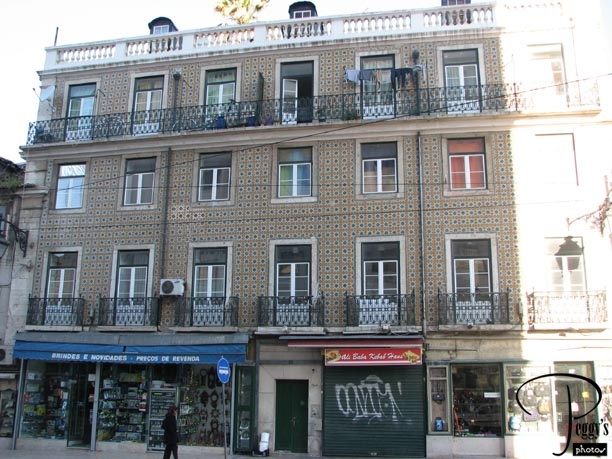
I left my hotel at 8:15 a.m. to meet my day tour group at the Hard Rock Cafe at 9 a.m. The hotel told me it was only a 5–minute walk but I left plenty of time in case I got lost. This building was a left turn from the hotel––the first of many buildings that I saw in Portugal that have tiled fronts.

Lisbon Walk
Lisbon Walk
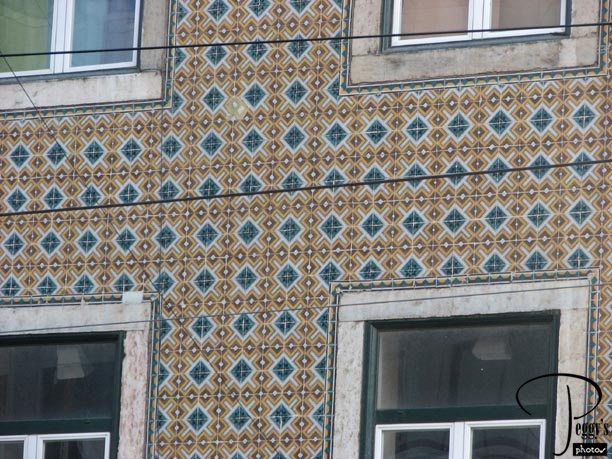
Close–up of the tiles.

Lisbon Walk
Lisbon Walk
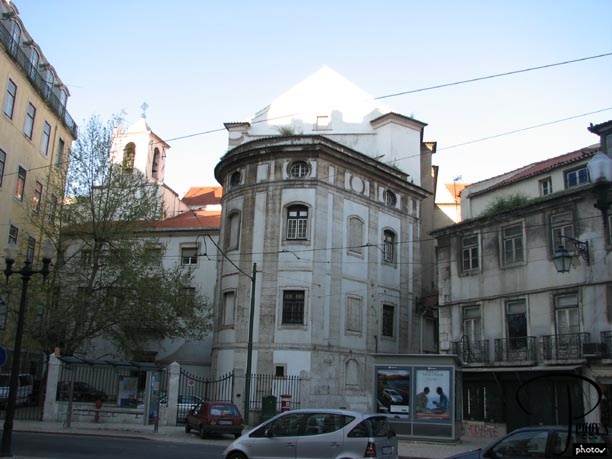
Further along, the back of the Sao Domingos Church.

Lisbon Walk
Lisbon Walk
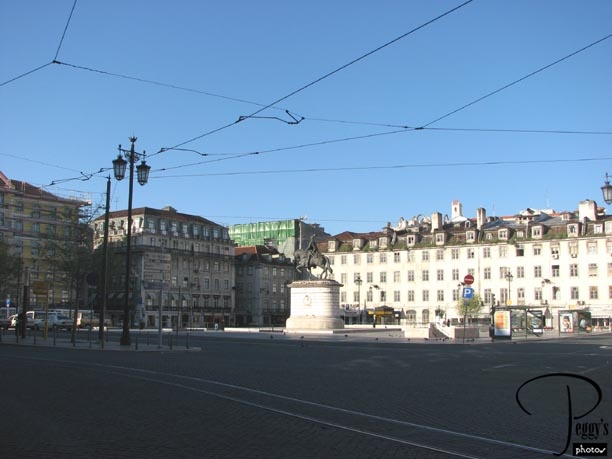
Walking past the Praca da Figueira.

Lisbon Walk
Lisbon Walk
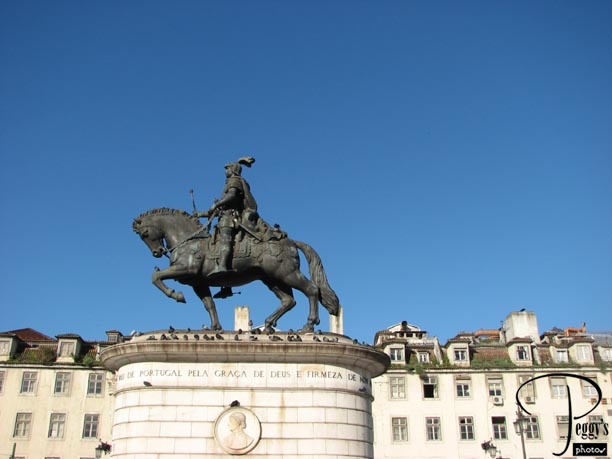
Close–up of the statue of King John I in Praca da Figueira.

Lisbon Walk
Lisbon Walk
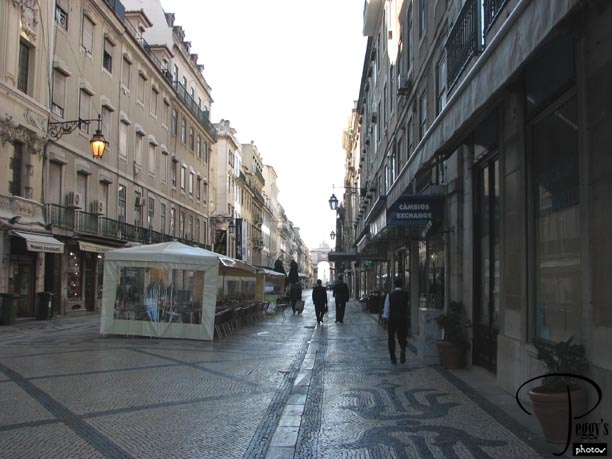
Even with a Lisbon map and directions from my hotel, I started to walk in the wrong direction. My lack of a sense of direction did not fail me. However, I recognized this pedestrian street, the Rua Augusta, from one of my Portugal guides, and knew more or less how I went wrong. The Rua Augusta will take you down to the River Tejo.

Lisbon Walk
Lisbon Walk
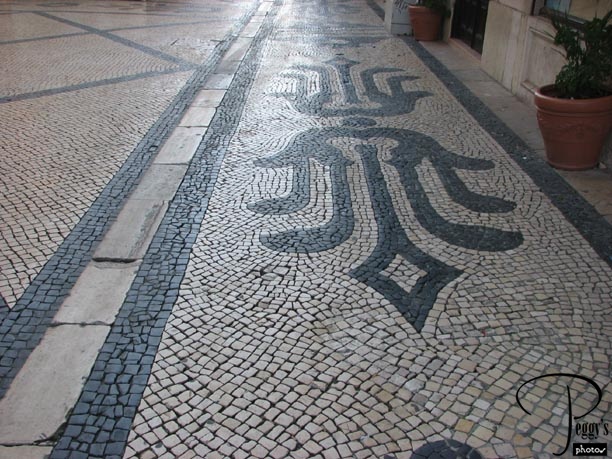
Not only the pedestrian streets, but also almost every sidewalk in Portugal is cobblestoned. Here, the white cobblestones are of limestone and the black ones are of basalt. Designs often appear on the sidewalks. But not only are the sidewalks cobblestoned, a good number of the streets that you will walk on are also, so take a pair of nonslip shoes with you.

Lisbon Walk
Lisbon Walk
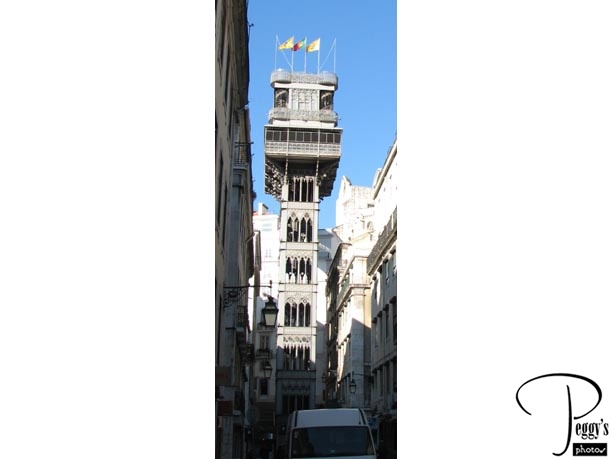
I turned around to go back in the direction that I had come from and my eye caught what I believe is the most incredible structure in Lisbon––the Elevador de Santa Justa. It will take you from the flat Baxia area (where I now was) up the hill to the Bairro Alto. I went up and down it a couple of days later, so more photos and description of it on another album.

Lisbon Walk
Lisbon Walk
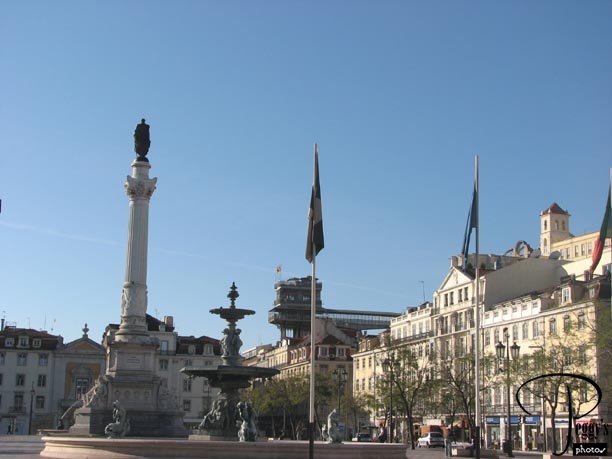
I am now at the Praca de Dom Pedro IV (also called Rossio). This square runs right into the Praca de Figueira and that is how I got turned around as I didn’t expect to see two main squares side by side. You can see the Elevador de Santa Justa in the background. The statue is of Pedro IV, the King of Portugal and Emperor of Brazil. I now asked a taxi driver at the taxi stand for further directions.

Lisbon Walk
Lisbon Walk
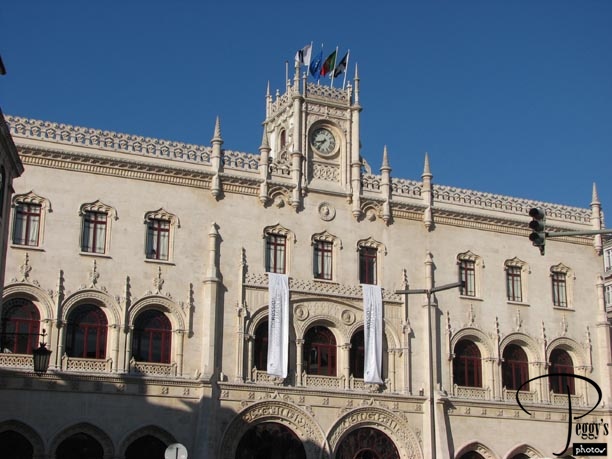
Now I am going in the right direction to the Praca dos Restauradores (this square doesn’t have anything to do with restaurants, rather with the restoration). I passed the Rossio train station.

Lisbon Walk
Lisbon Walk
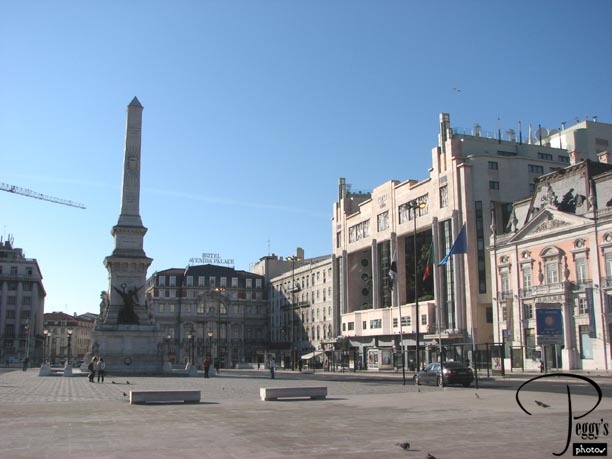
The Praca dos Restauradores. The building to the right of the obelisk is the Avenida Palace Hotel, the oldest hotel in Lisbon and now part of the Westin chain. It is probably the best located hotel in Lisbon. The tallest building is the Art Deco Eden Theatre of the 1920s.

Lisbon Walk
Lisbon Walk
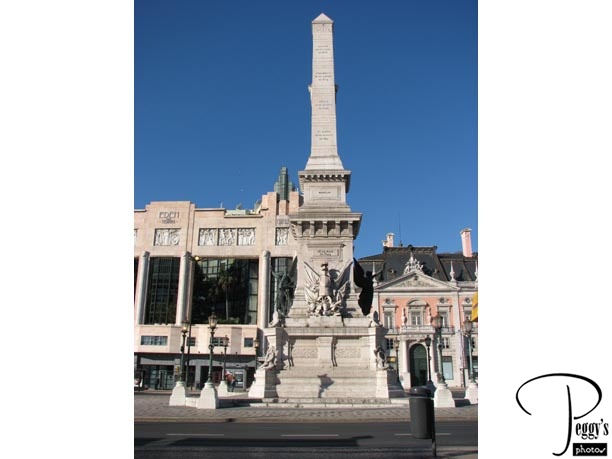
The obelisk was errected in 1886 and commerates Portugal’s liberation from Spain.

Lisbon Walk
Lisbon Walk
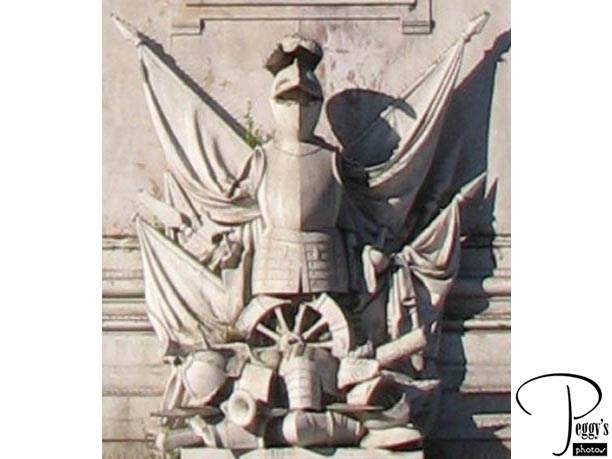
Close–up of one of the figures on the obelisk.

Lisbon Walk
Lisbon Walk
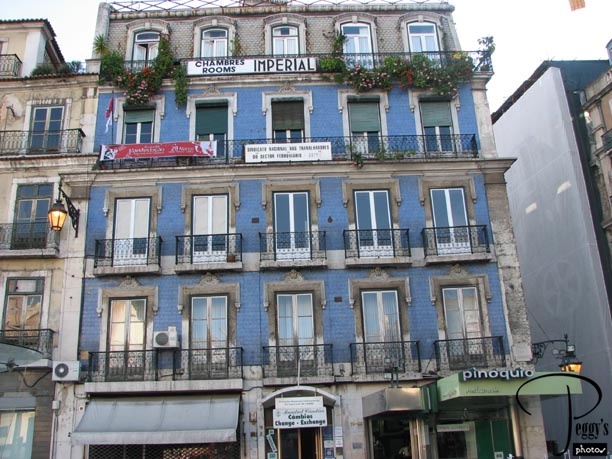
I saw this interesting building on the other side of the Praca dos Restauradores, the Imperial, offering chamber rooms.

Lisbon Walk
Lisbon Walk
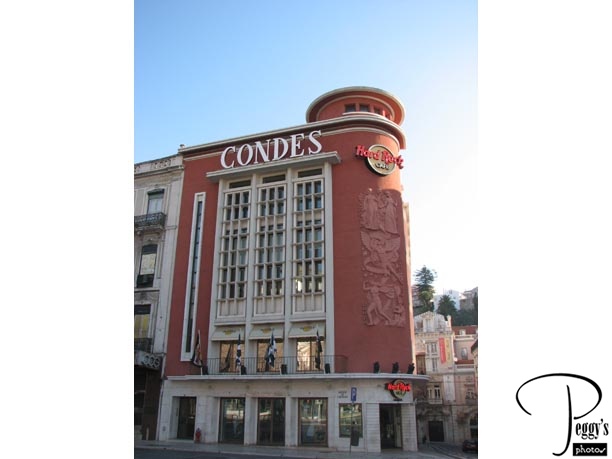
With a great sigh of relief, I found the Hard Rock Cafe. I was even a bit early. I had booked a tour to Sintra, Cascais, etc., with the Inside Lisbon tour group: www.insidelisbon.com. This is an absolutely excellent tour company and I spent much of the four days I spent in Lisbon on my own with this group. I was somewhat apprehensive about spending Easter weekend in Lisbon––Would everything be closed and no one in Lisbon? Actually, most places were open, and since Good Friday is a national holiday in many European countries, many Europeans were in Lisbon taking advantage of the three–day weekend.

Lisbon Walk
Our Tour Group
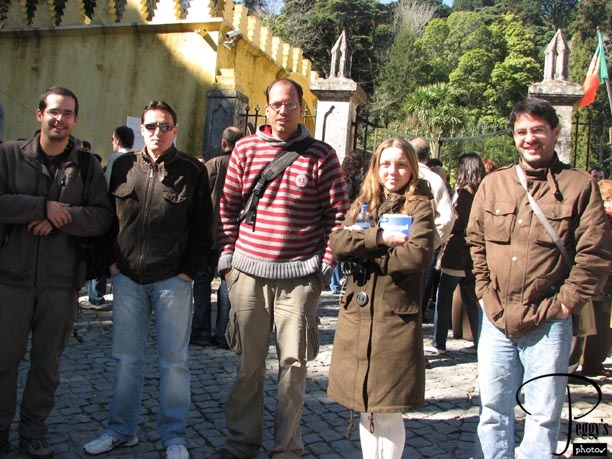
Inside Lisbon came with two vans––too many people showed up for just one. Hugo, our tour guide, is on the left of this photo. I already felt that I knew him as I had e–mailed him twice before coming to Portugal to inquire about the tours. I never got the names of the three great young men in the photo, but the second from left is from Bulgaria and is working in Madrid. The middle young man is from Peru and works in Madrid. Next comes Rose, a very mature 20–year–old from Russia on vacation; and finally, another young man also from Peru who is studying for a Doctor of Laws in Human Rights in Madrid and who rooms with the man from Bulgaria. The people who were taken in the other van were a couple from Helsinki, Finland, and a couple from Germany, plus another man but I didn’t find out where he was from. Throughout my stay in Lisbon, I met more people from different countries of Europe than on any other trip I have taken––it was a very exciting occurrence.

Our Tour Group
Onward to Sintra
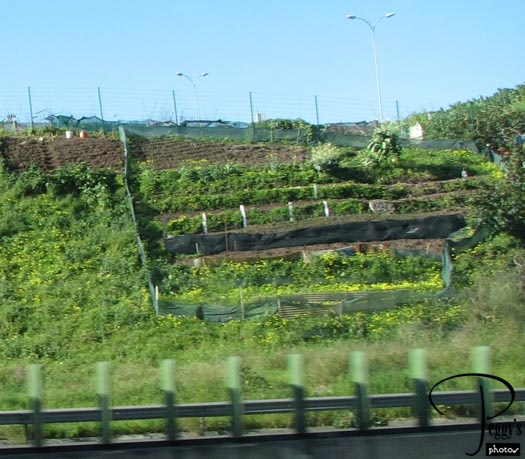
One of two very interesting things I saw on the way to Sintra: the vegetable gardens on the sides of the freeways. Hugo said that people have to bring their own water supply if it hasn’t rained enough.

Onward to Sintra
Onward to Sintra
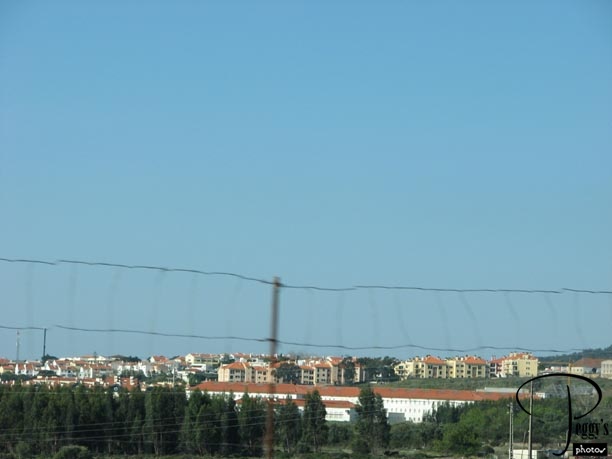
The second: There are many areas of Portugal that resemble California––or you could say that California resembles Portugal depending on your frame of reference. There are areas where white houses with red tiles roofs hug the rolling hills and many of the houses and apartment buildings are similar to the new ones in California. Also, about 90 percent of the plants and trees in Portugal are also grown in California. Our climates are similar though Portugal has much more rain than we have. Photo: Some high rise apartments that we passed.

Onward to Sintra
Sintra
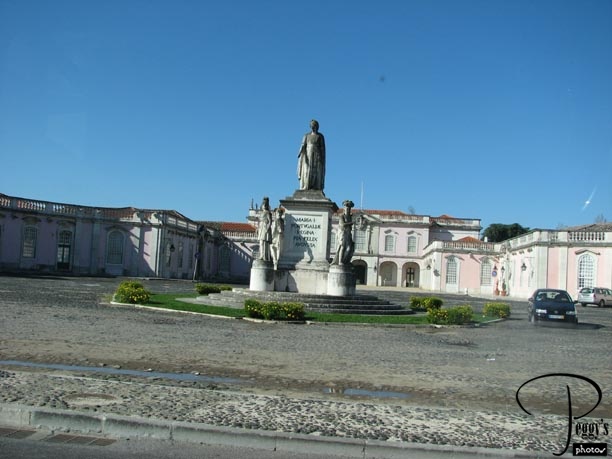
Several miles outside of the main area of Sintra is one of the five Sintra palaces: the Palacio de Queluz, built in 1747 by Pedro, the son of John V. He transformed a 17th–century hunting lodge into a Rococo summer palace. We only made a photostop here.

Sintra
Sintra
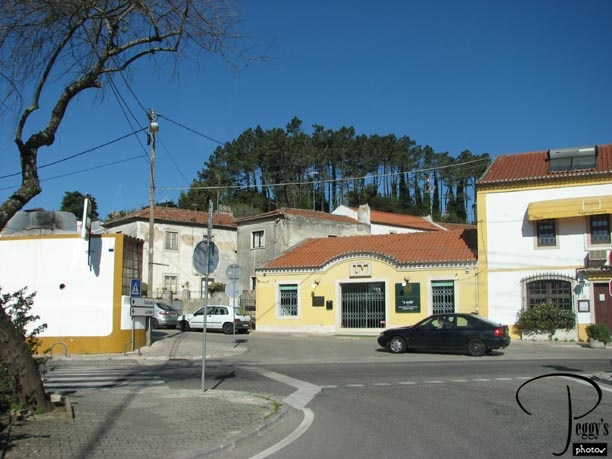
Our first look at Portuguese–style houses––usually white with yellow trim and red tiled roofs.

Sintra
Sintra
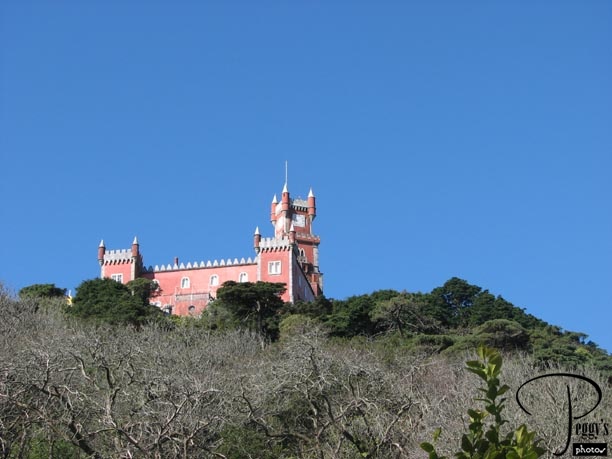
Our first view of the Pena Palace located on the highest peak of the Serra de Sintra.

Sintra
Pena Palace
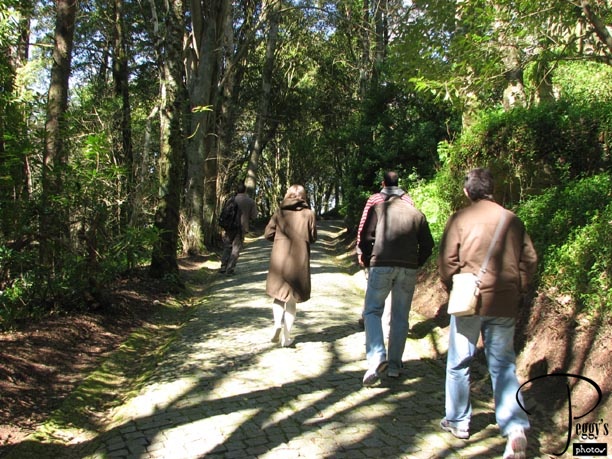
Hugo got our tickets to the Pena Palace and then we all walked up the steep cobblestoned trail. We were walking through a forest which Hugo told us was planted when the Pena Palace was built.

Pena Palace
Pena Palace
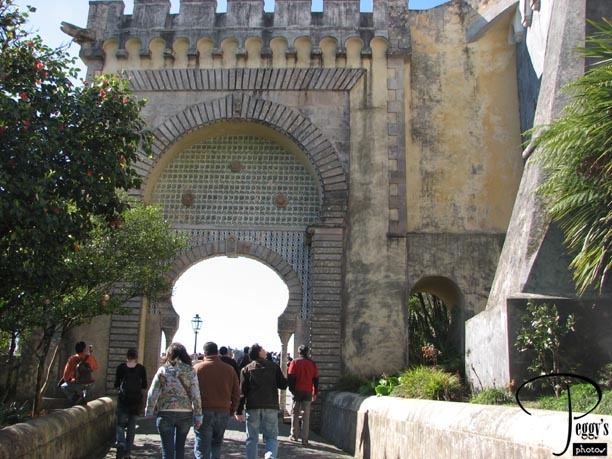
The entryway to the palace.

Pena Palace
Pena Palace
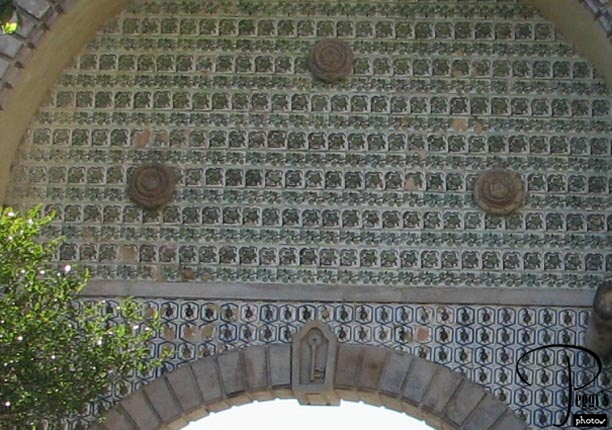
The key on the entryway represents the key to your spiritual journey as you enter the castle grounds. The roses represent letting your heart make this spiritual journey.

Pena Palace
Pena Palace
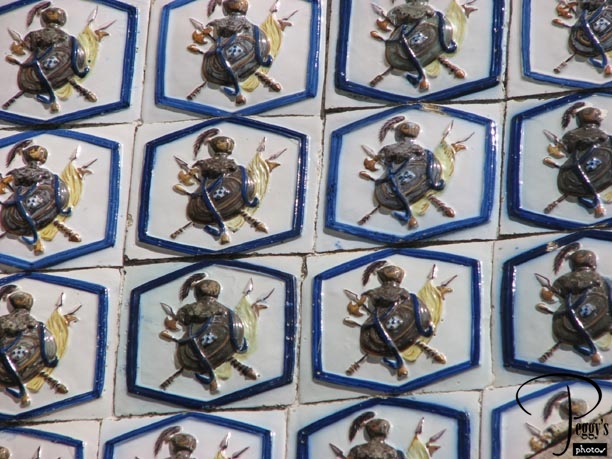
Close–up of the bottom tiles of the entryway.

Pena Palace
Pena Palace
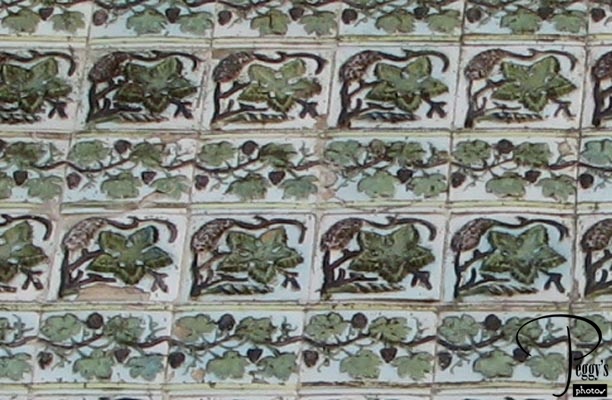
Close–up of the top tiles of the entryway.

Pena Palace
Pena Palace
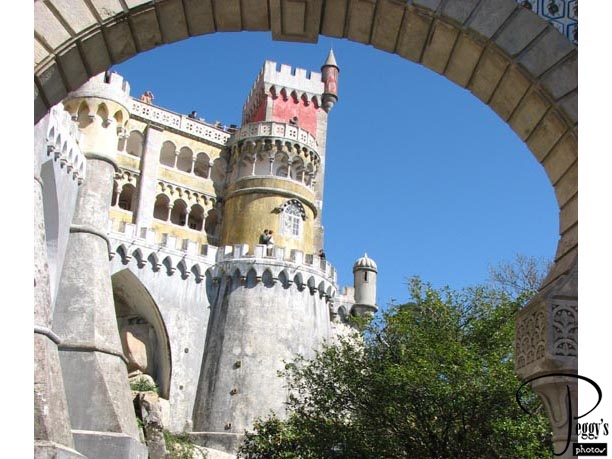
Looking at the palace through the entryway. Pena Palace was the brainchild of a romantic German–born prince named Ferdinand. He hired a German architect to build a fantasy castle of Gothic towers, Renaissance domes, Moorish minarets, and Manueline carvings. The result is wonderful.

Pena Palace
Pena Palace
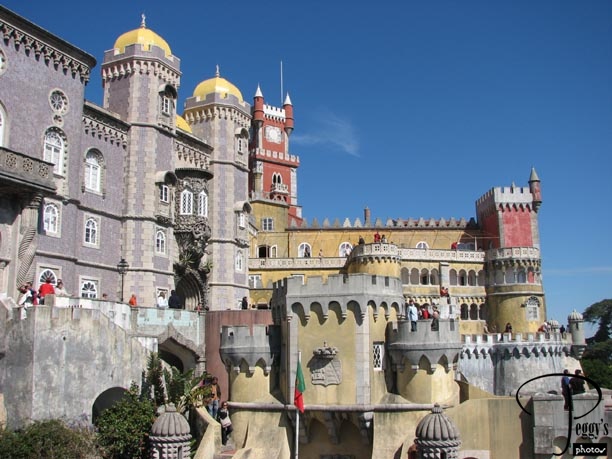
Another view of the palace.

Pena Palace
Pena Palace
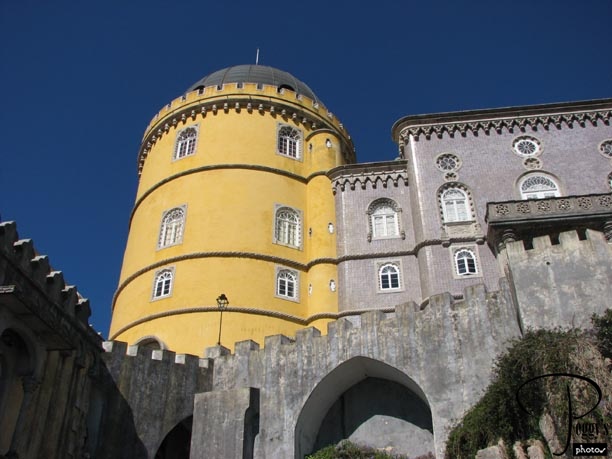
Another view.

Pena Palace
Pena Palace
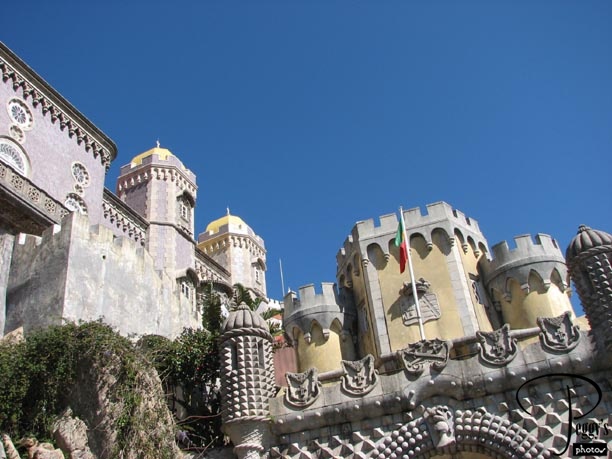
And another.

Pena Palace
Pena Palace

Entrance to the courtyard with the Monster of the Sea looking down to see who enters. The arch and the window are of Manueline decoration, which comes from the reign of Manuel I (1495–1521) during Portugal’s Great Period of Discoveries. It consists of very decorative maritime motifs including twisted ropes, armillary spheres, anchors, etc.

Pena Palace
Pena Palace
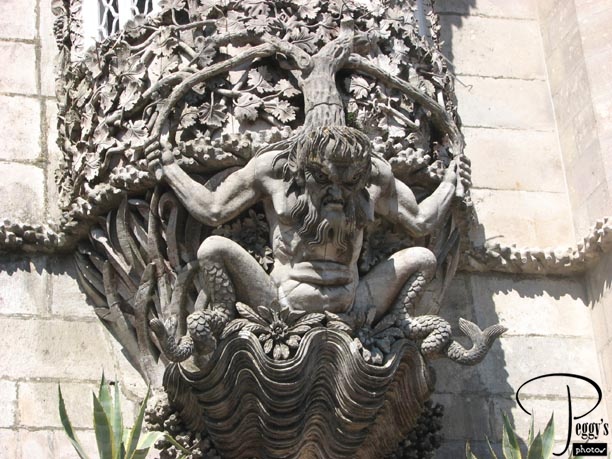
Closer view of the Monster of the Sea.

Pena Palace
Pena Palace
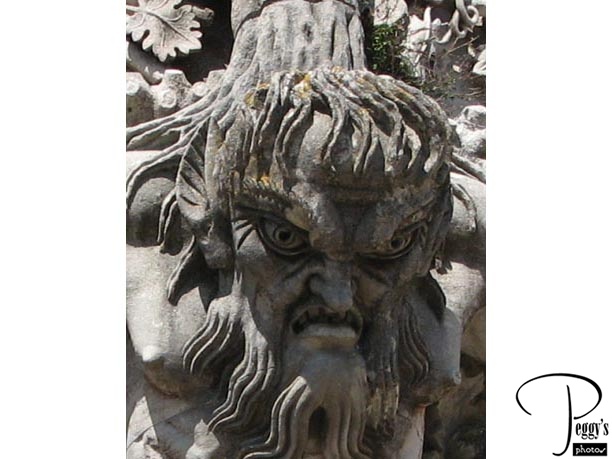
And an even closer view.

Pena Palace
Pena Palace
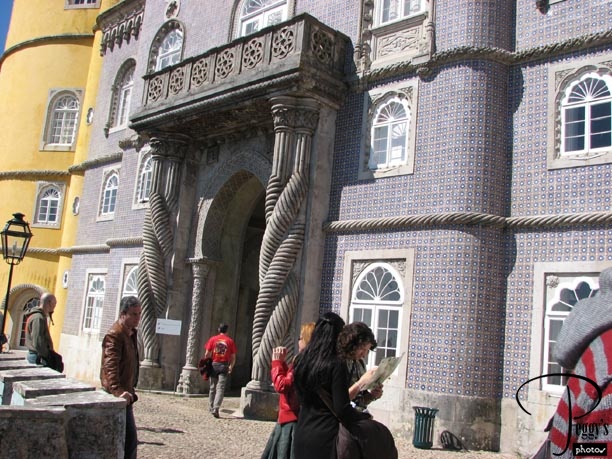
Another entrance arch with the twisted ropes of Manueline architecture.

Pena Palace
Pena Palace

Inside the courtyard. Pena Palace was built on the grounds of a former monastery. These arches were part of the monastery.

Pena Palace
Pena Palace
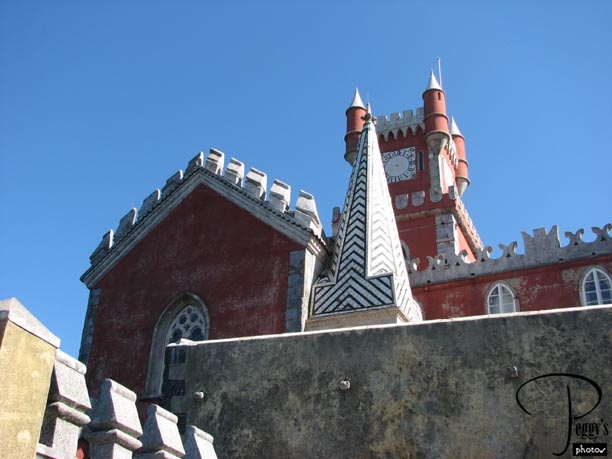
View of the palace from the courtyard. We next went through the rooms of the palaces. However, photos weren’t allowed. The inside rooms contained furniture, ceramics, paintings, etc., and were interesting.

Pena Palace
Pena Palace
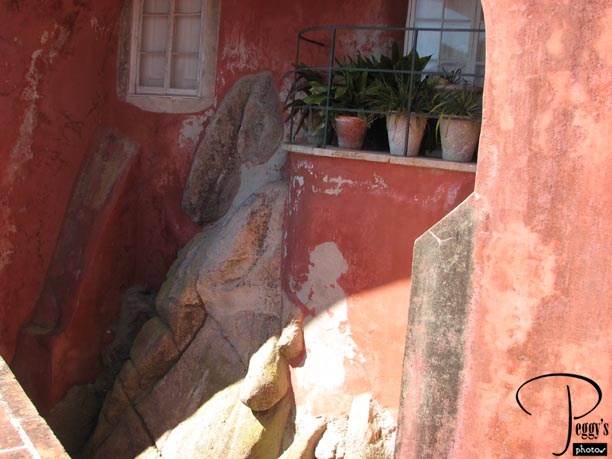
Here you can see that the palace was built right into the rock of the mountain.

Pena Palace
Moorish Castle
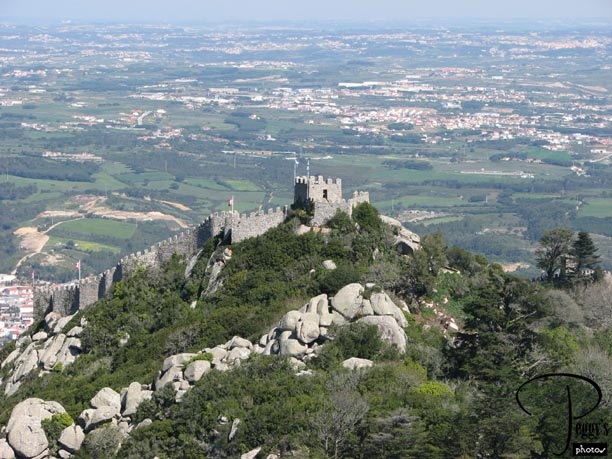
The 1000–year–old Moorish Castle ruins seen from Pena Palace. The ruins were restored in the 19th century. We didn’t visit the castle, but Hugo told us that the best view of the castle is from here and that it is nothing but a shell.

Moorish Castle
A Castle Home
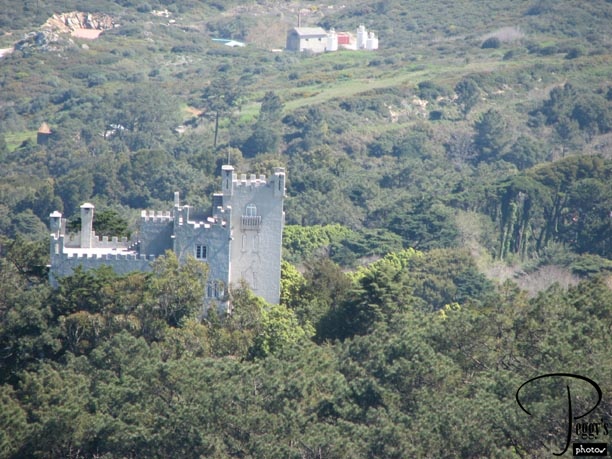
Just somebody’s home built like a castle, seen from Pena Palace.

A Castle Home
Pena Palace
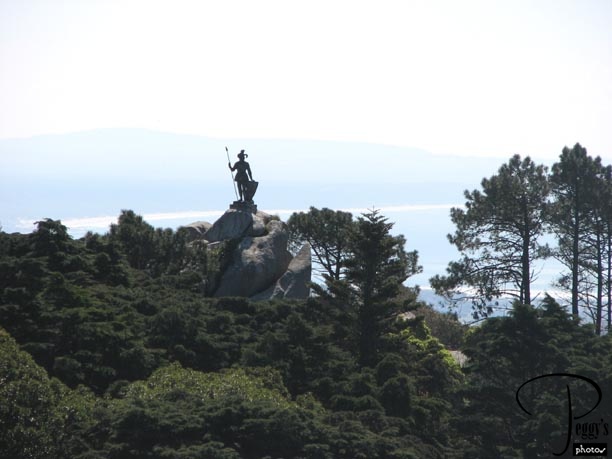
Statue seen from Pena Palace. Hugo said that it is of the palace’s architect, Baron von Eschwege.

Pena Palace
Pena Palace
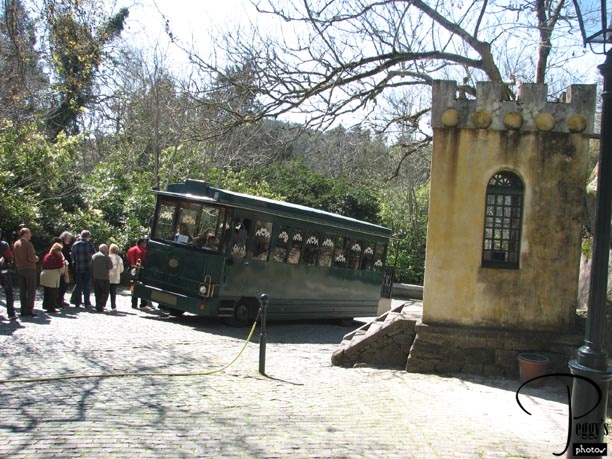
We started our walk down to the van. Here is the tram that we didn’t take either up or down the hill.

Pena Palace
Walk Back to Sintra
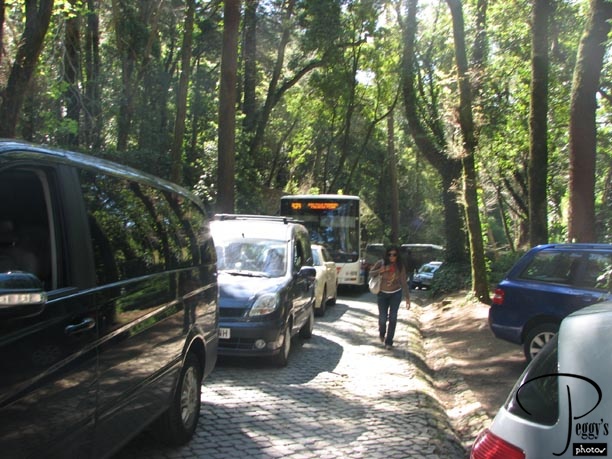
Hugo went to retrieve the van parked on the side of the road, but he came back to report that he couldn’t move it as there was a monumental traffic jam blocking it. What had happened is that too many Spanish tourists had decided today was their day to come to see Pena Palace. We knew they were Spanish as there was the letter E for Espana on their license plates. The winding road up to the top of the mountain is only one way. So when drivers got to the top of the mountain and couldn’t find a parking space, they just stopped there until a parking space was free. So nobody behind them could move. It looked hopeless, so all of us except Hugo (we left him with the van) decided to walk down the mountain to the town of Sintra. About 45 minutes to an hour later, we were only about 100 yards from our destination when Hugo drove up to take us the rest of the way down. We met many people walking up the mountain––they either got out of cars and left their drivers to wait for a let up in the traffic jam or even started at the bottom of mountain because they had heard of the traffic jam.

Walk Back to Sintra
National Palace
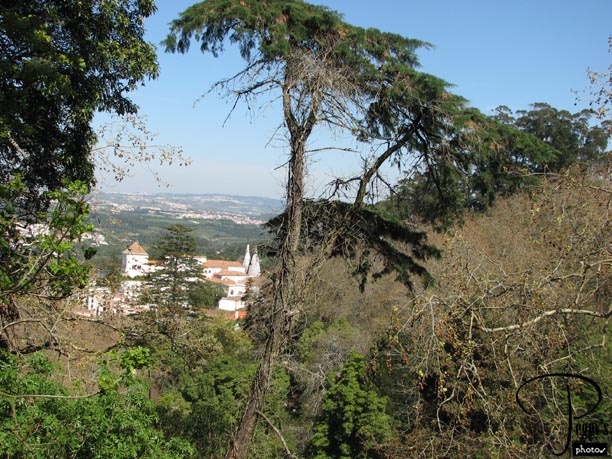
View of the National Palace seen on our walk down the mountain.

National Palace
Sintra
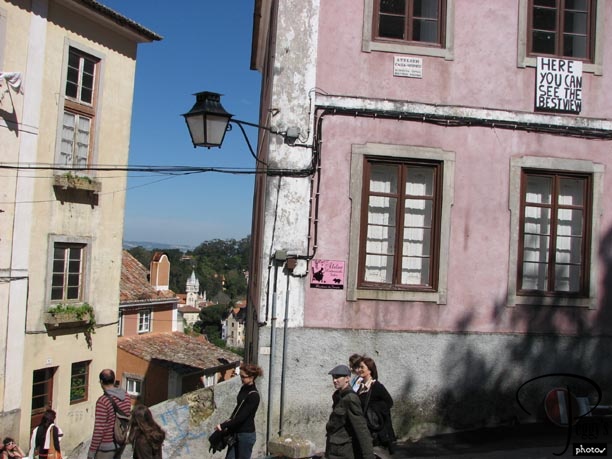
Hugo dropped us off here and told us how to get down to the town center.

Sintra
Sintra
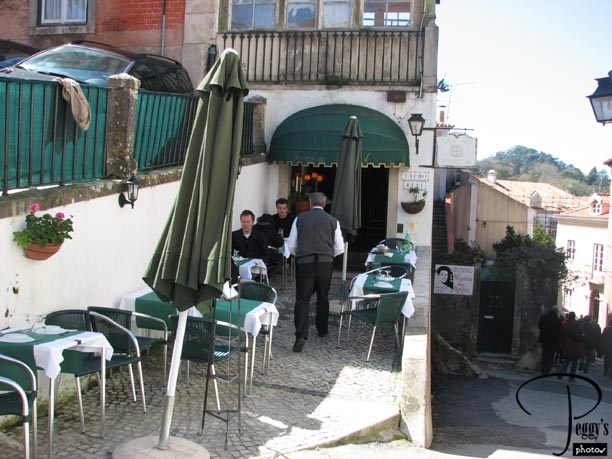
Cafe on the way down to the town center.

Sintra
Sintra
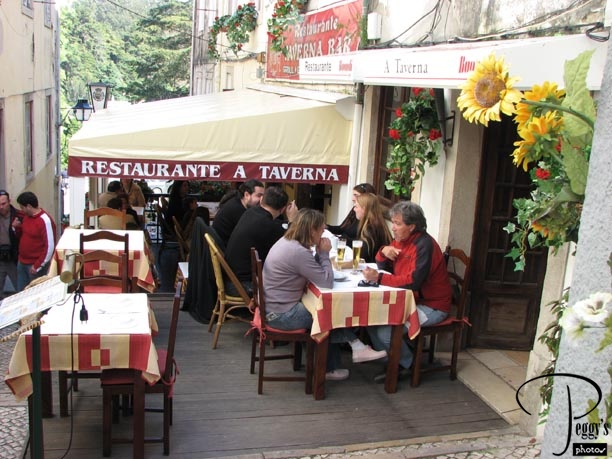
We all were hungry and looked for a cafe that wasn’t too crowded. We ended up at this taverna.

Sintra
Sintra
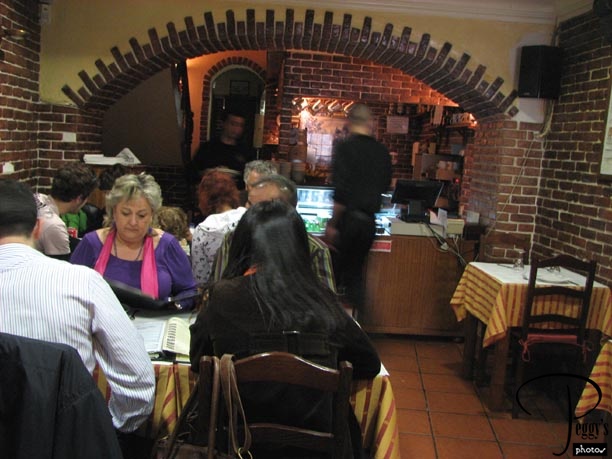
We ate together inside the taverna. I had a delicious tuna salad (9,50 euros) and Diet Coke (2,40 euros), and my share of the cost of the bread served was 2,50 euros (you pay for bread with your meals in Portugal).

Sintra
National Palace
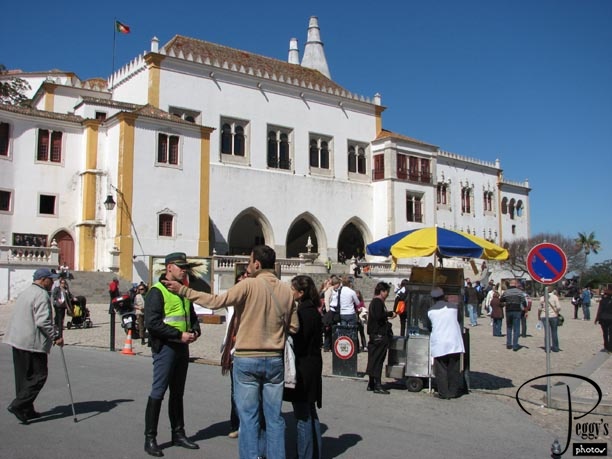
We walked over the National Palace which is located in the town center. The palace dates back to Moorish times, but most of it is from the 15th century reign of John I. It is the oldest surviving royal palace in Portugal. I didn’t go inside as no photos were allowed and I preferred to use my time to take some outside photos. The smokestacks on the roof are above the palace’s kitchens.

National Palace
National Palace
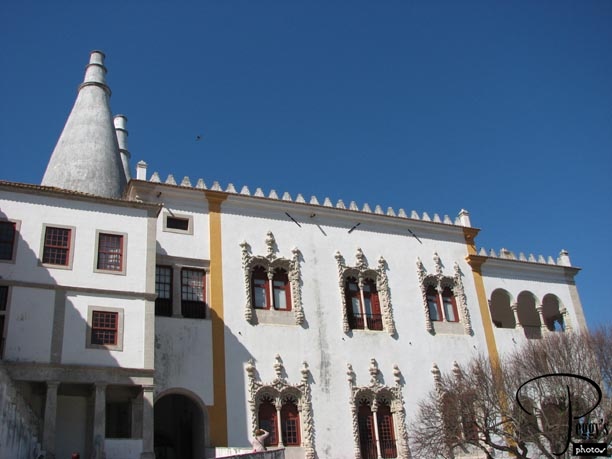
The decorations around the windows are of Manueline architecture but they were added later in the 16th century.

National Palace
National Palace
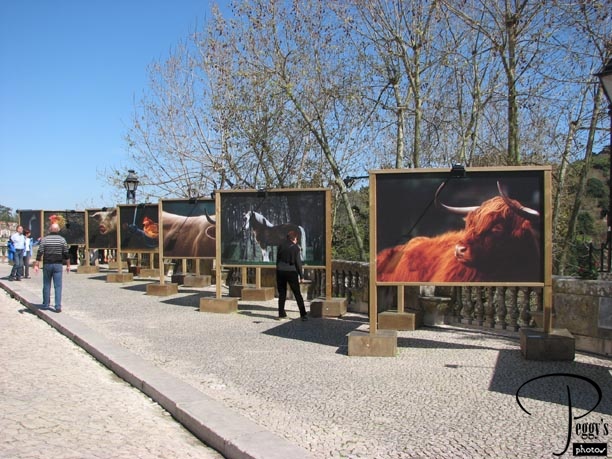
These boards were in the courtyard in front of the palace. I do not know what their significance is.

National Palace
National Palace
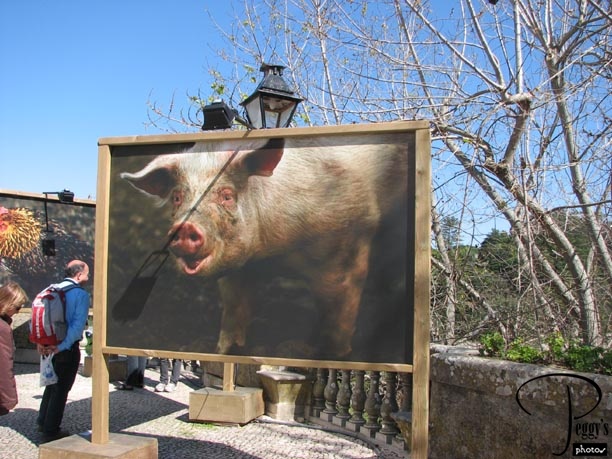
Close–up of one of the boards.

National Palace
Sintra
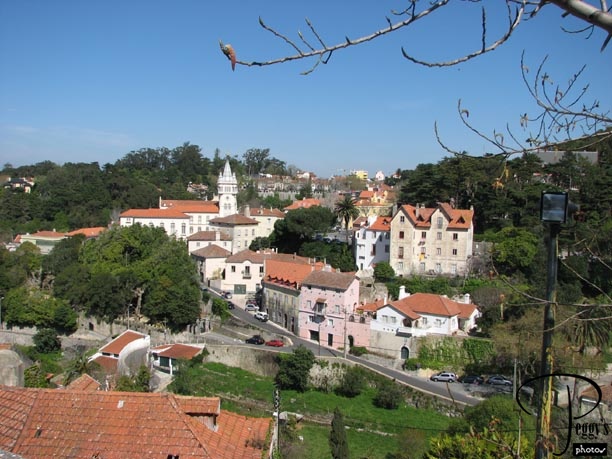
View of Sintra from the National Palace.

Sintra
Statue
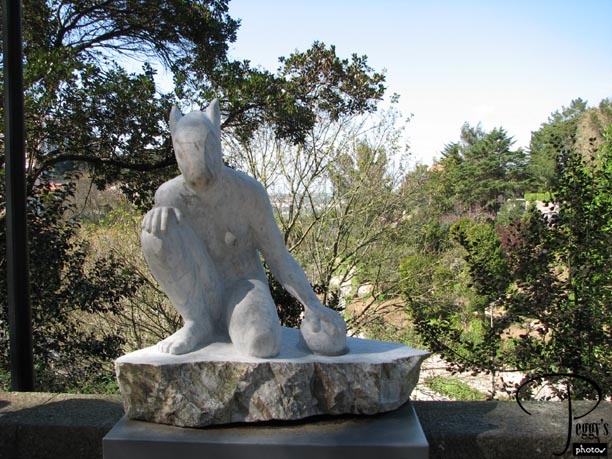
I passed this bunny statue on my way down the hill to get a good photo of the National Palace.

Statue
National Palace
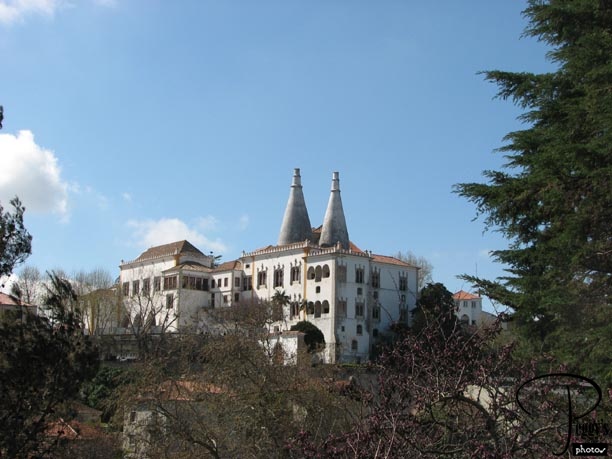
A good photo of the palace showing its odd smokestacks.

National Palace
Sintra
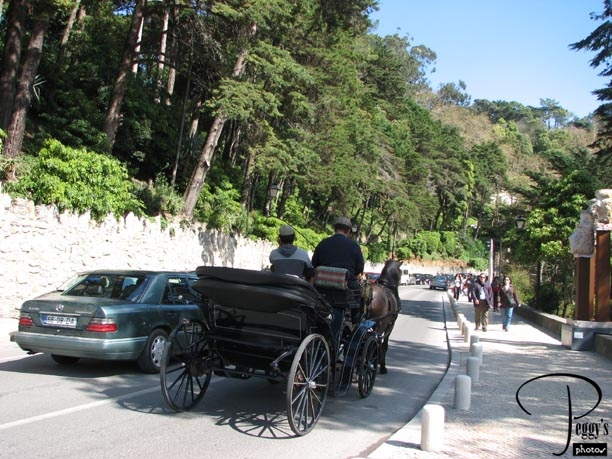
One mode of transportation in Sintra. An aside: If you want to visit all the palaces and castles in Sintra, you really need about two days here. If you wish, you can take a shuttle from the Lisbon airport right to Sintra and start your Portugal journey there. There are shuttles in Sintra to take you to all the sites.

Sintra
Sintra
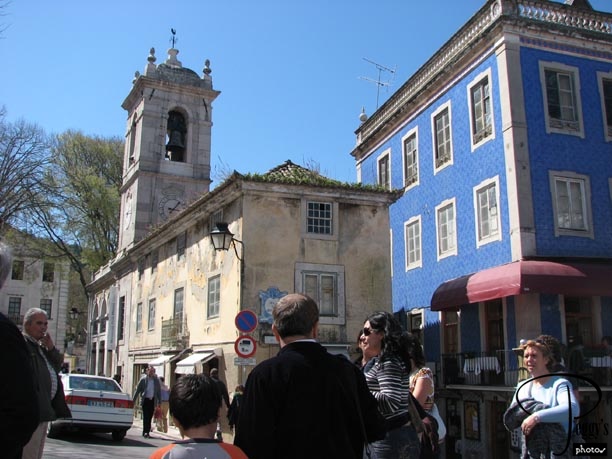
In the main square of Sintra.

Sintra
Sintra
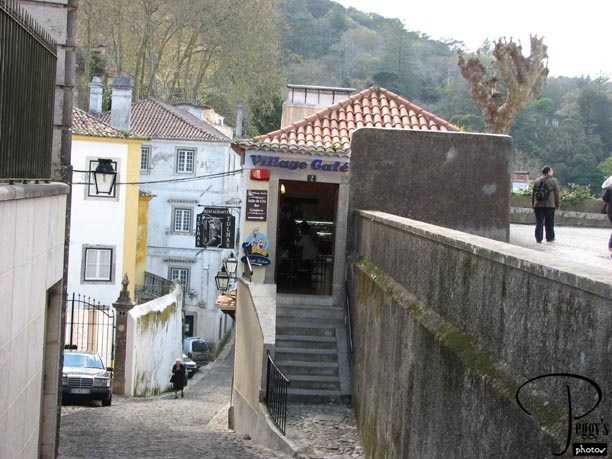
More of Sintra.

Sintra
Sintra
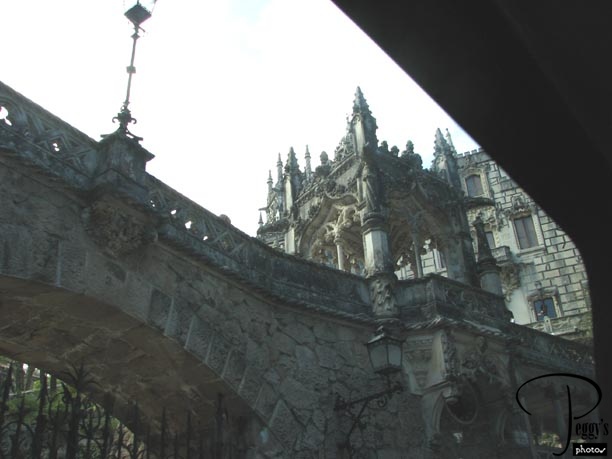
It was time to leave Sintra. I caught this photo of the Quinta da Regaleira from our van. It is a 1912 manor house and garden which Rick Steves describes as “neo–everything”: Manueline, Gothic, and Renaissance. It was designed by an Italian opera set designer for an eccentric millionaire. It is full of occult symbols and historic and religious references and also has extensive gardens. It looked like an interesting place to visit.

Sintra
Monserrate Palace
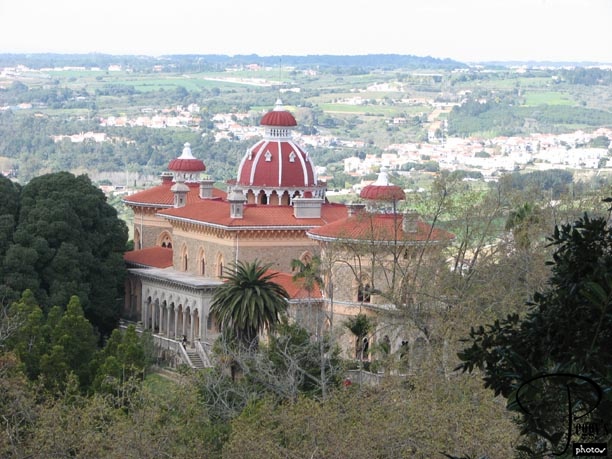
We had a quick photostop to take a photo of Monserrate Palace, another of Sintra’s palaces. It was built in 1858 in a Romantic–Oriental style. Hugo said there is nothing inside it.

Monserrate Palace
Cabo da Roca
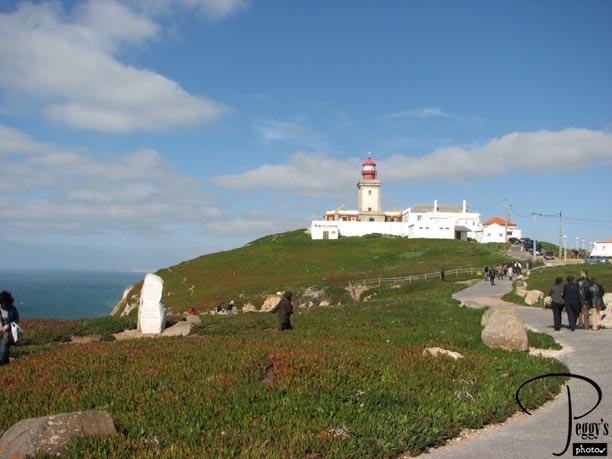
Our next stop was at Cabo da Roca, the westernmost point on the European continent. Photo of the Cabo da Roca lighthouse. It was very windy here and chilly.

Cabo da Roca
Cabo da Roca
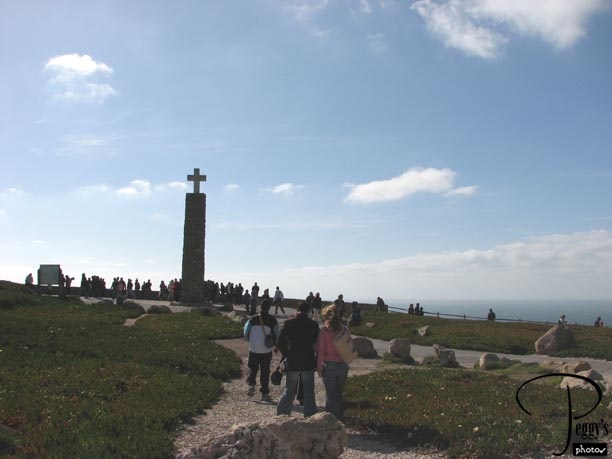
The cross at Cabo da Roca. The sun was in the wrong position to take a good photo.

Cabo da Roca
Cabo da Roca
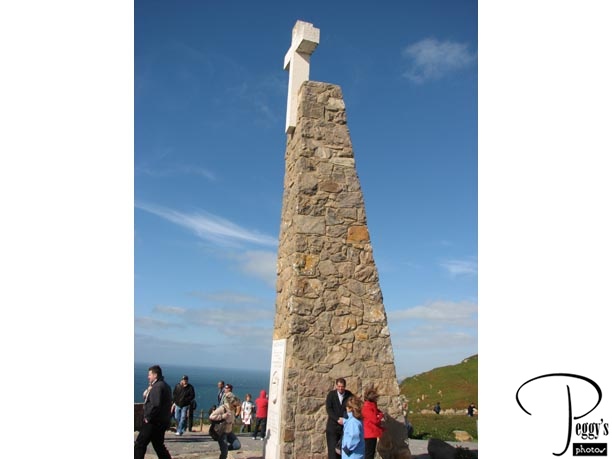
Closer–up view of the cross.

Cabo da Roca
On the Way to Cascais
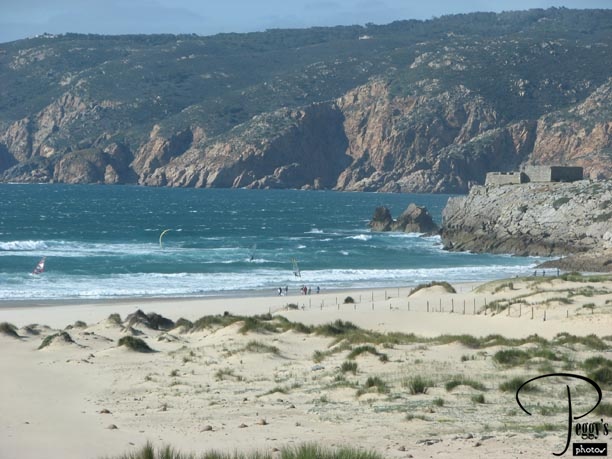
We stopped along the beach to take some photos. The wind was almost violent here, hence its popularity with wind surfers.

On the Way to Cascais
On the Way to Cascais
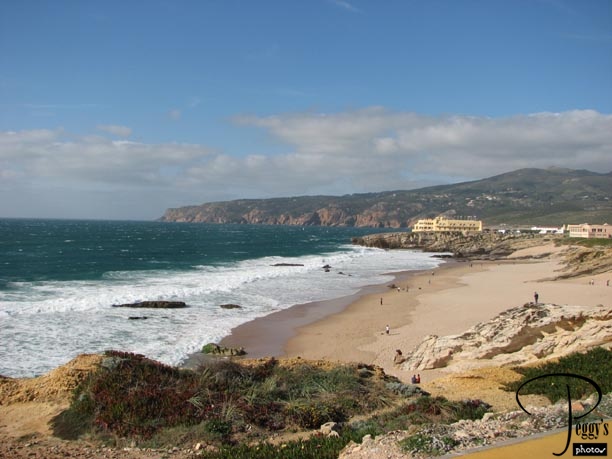
Guincho Beach with an old fort in the background.

On the Way to Cascais
On the Way to Cascais

Close–up of the fort, now a luxury hotel––the Fortaleza do Guincho. All throughout Portugal, we saw monasteries turned into museums and hospitals, parts of castles turned into pousadas (hotels), forts turned into hotels, etc., etc.

On the Way to Cascais
Cascais
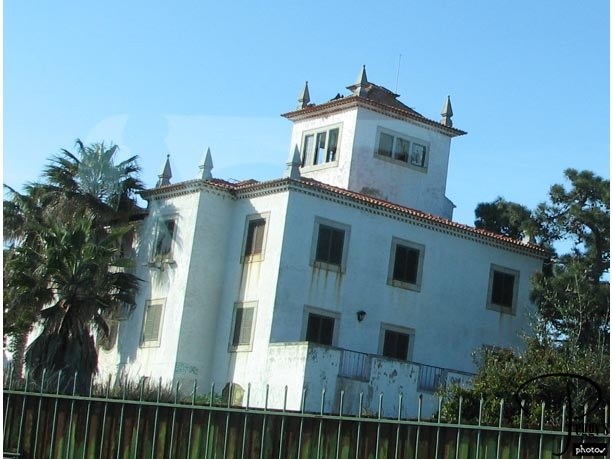
There were many mansions here in Cascais––it is a resort very close to Lisbon and people have first or second homes here. However, this is an available fixer–upper––first off, window panes are needed.

Cascais
Cascais
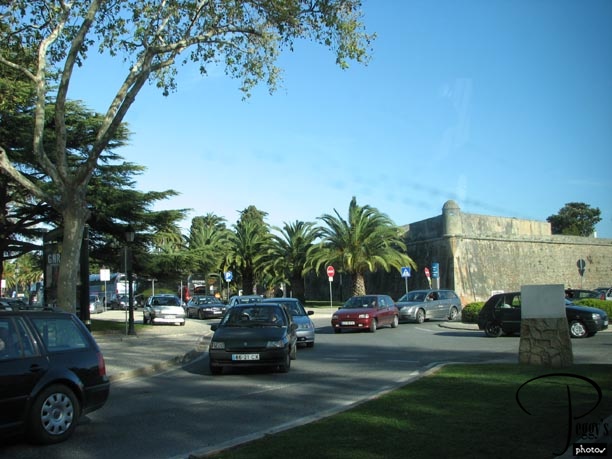
The 16th–century fortress of Cascais. It was part of a line of fortresses to keep Lisbon from being invaded.

Cascais
Cascais
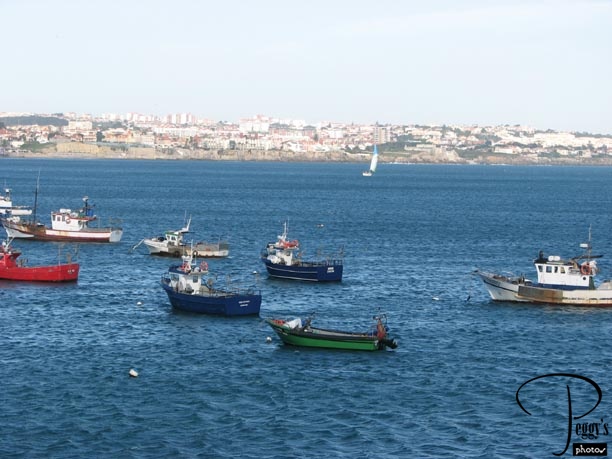
Fishing boats in the bay. Very windy by the water.

Cascais
Cascais

Octopus traps on the pier.

Cascais
Cascais
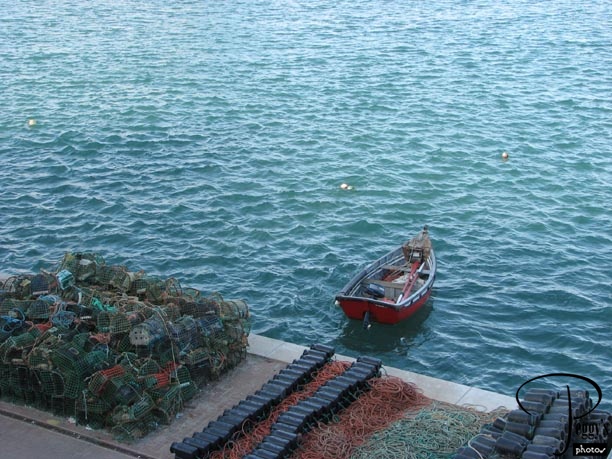
Closer–up view of the traps. The octopus are supposed to think that the black rubber traps are great hiding places. I don’t know how the other traps are to work.

Cascais
Cascais
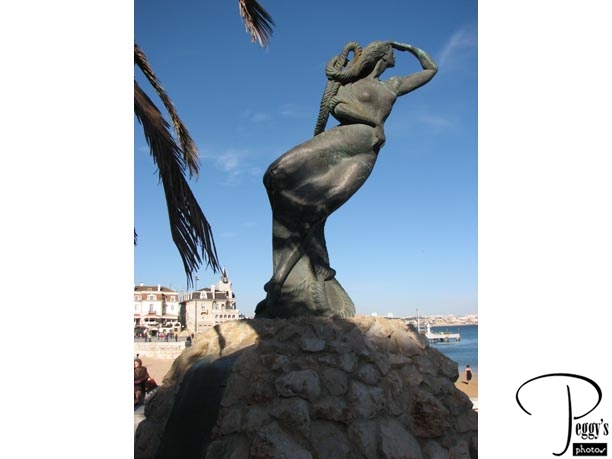
Mermaid statue looking out to the sea.

Cascais
Cascais

Boats on the boardwalk.

Cascais
Cascais
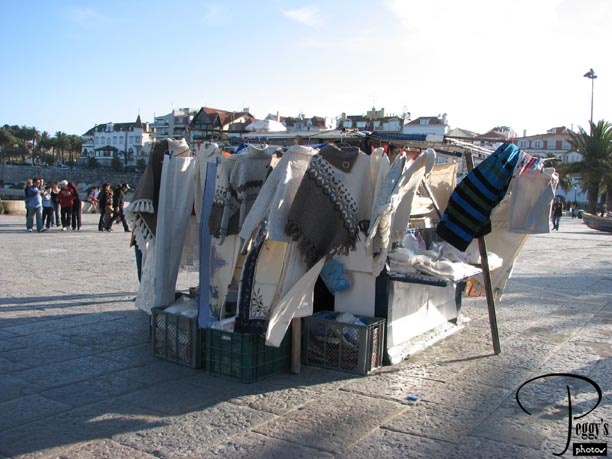
Wool fisherman sweathers and ponchos for sale in the wind.

Cascais
Cascais
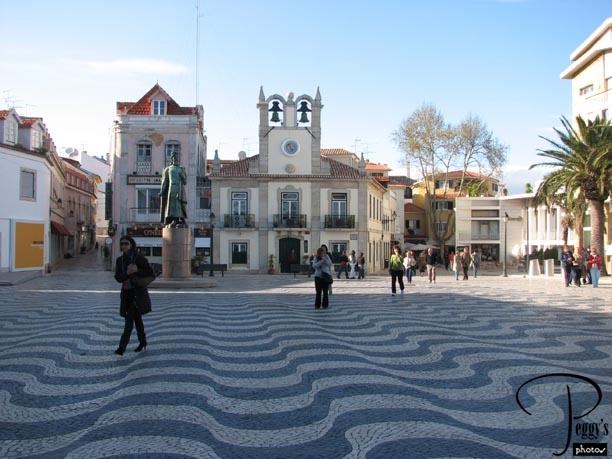
A Cascais square. The sidewalk design represents the waves of the ocean.

Cascais
Cascais
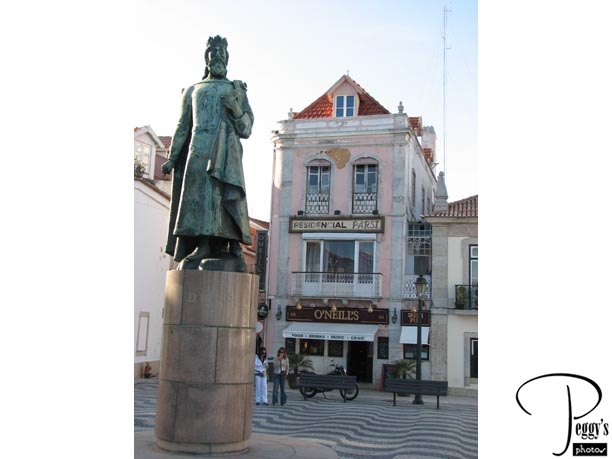
Statue of King Peter I at the square.

Cascais
Cascais
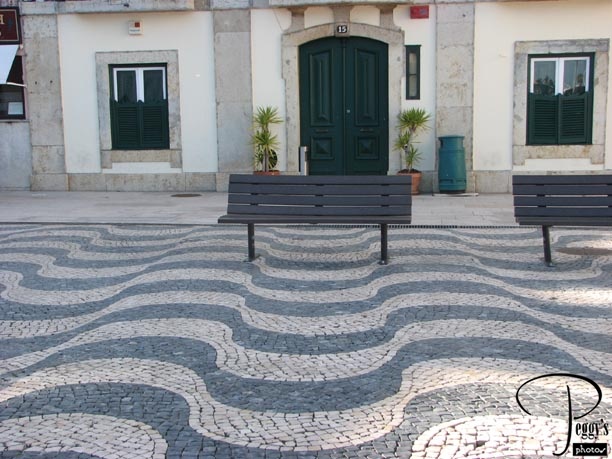
Bench seating on the “waves.”

Cascais
Cascais
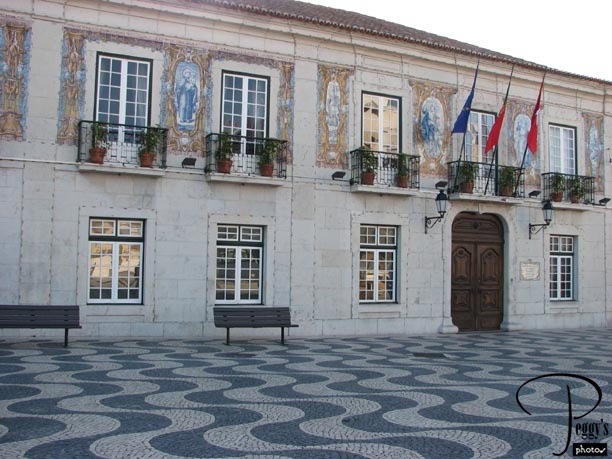
Probably the town hall, also in this square.

Cascais
Cascais
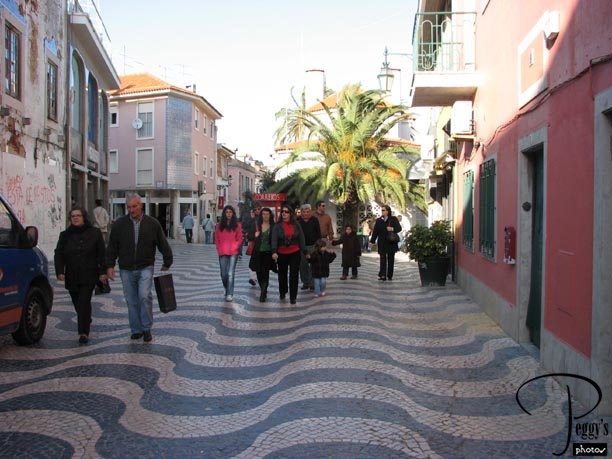
Side street Cascais. I found a pastelaria (pastry shop) here and had coffee and a piece of very good cake for 3,90 euros, very reasonable.

Cascais
Cascais
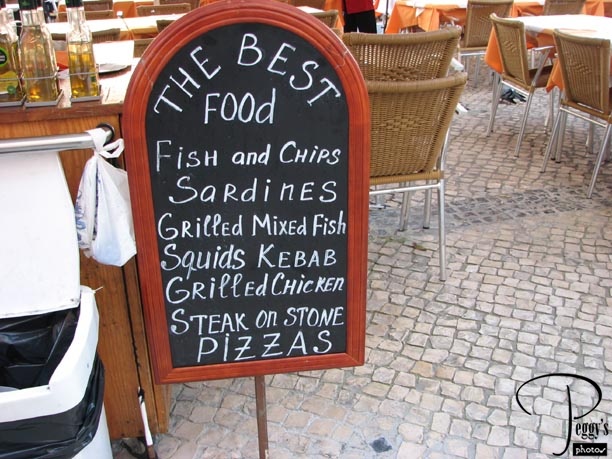
Portuguese menu in Cascais.

Cascais
Cascais
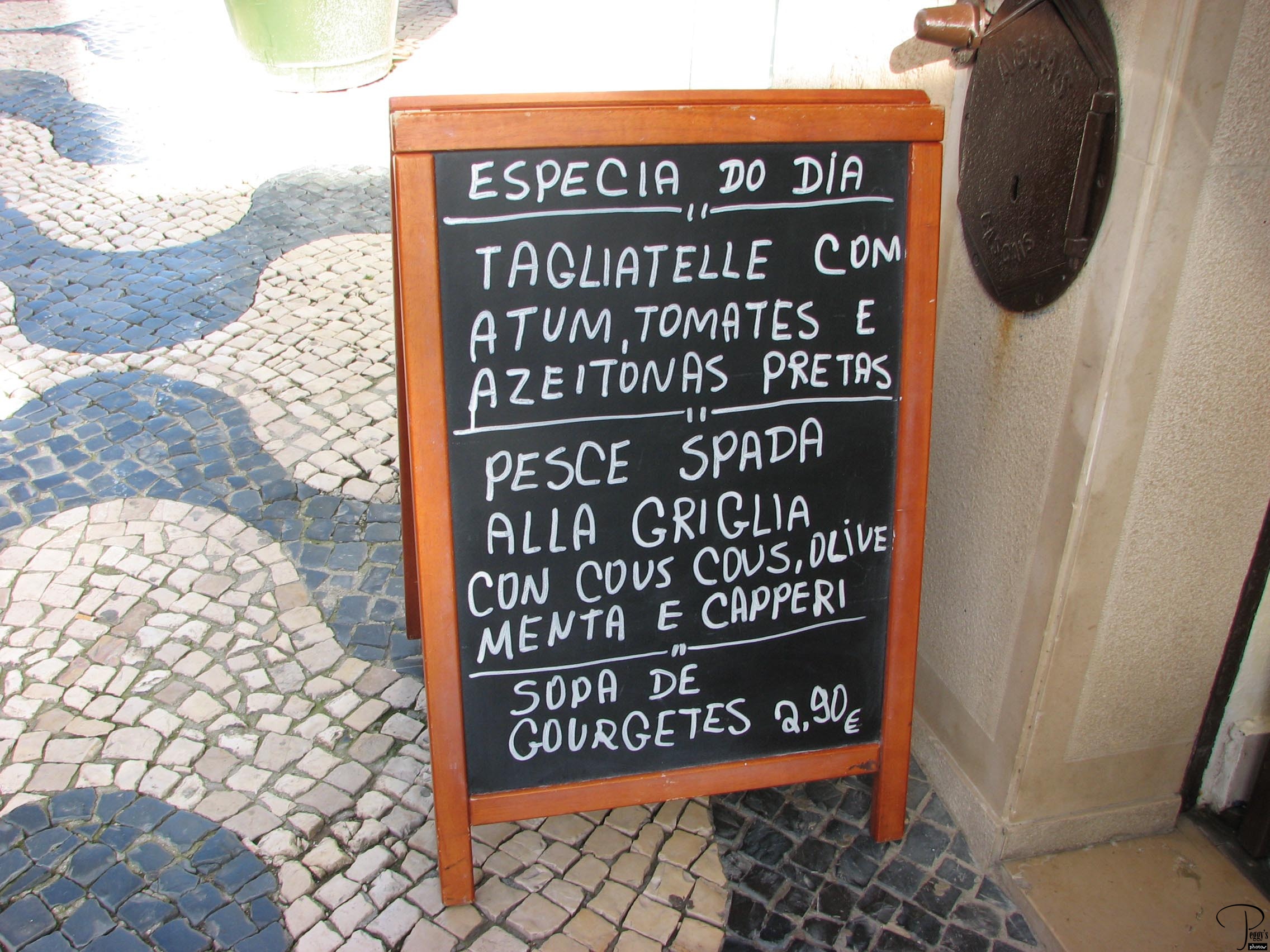
This one you may have some difficulty with.

Cascais
Estoril
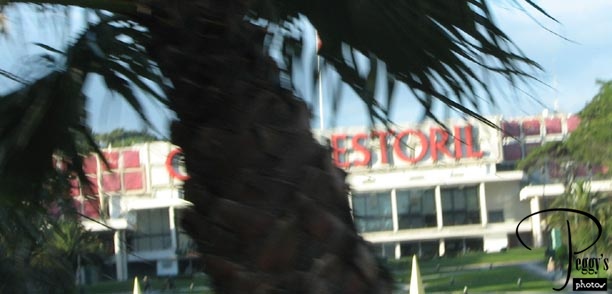
We drove past Estoril, another beach resort. I didn’t get any photos of the beach as I was on the wrong side of the van. However, I did catch this poor shot of the Casino Estoril, which is the largest casino in Europe and also the casino that Ian Fleming’s “Casino Royale” was based on.

Estoril
Estoril
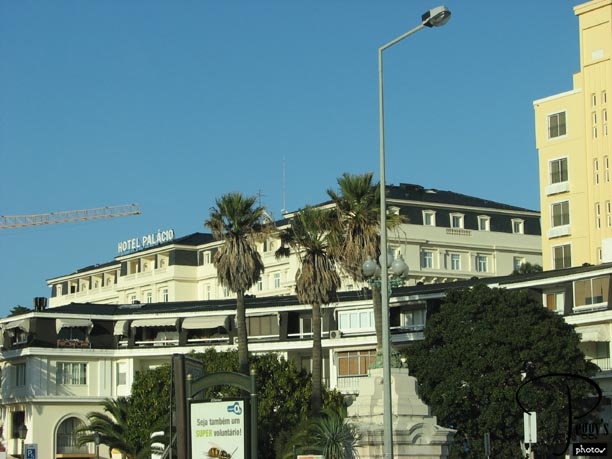
The Hotel Palacio, next to the Casino Estoril. As Portugal was neutral during World War II, spies on both sides of the war gathered here, many staying at the Hotel Palacio. This hotel also figures into the book “Casino Royale.” We were soon back in Lisbon. My wonderful tourmates and I hugged goodbye––we really bonded––and Hugo kissed both my cheeks Portuguese–style. Hugo was like a friend showing us the sights. What a great first day I had in Portugal. I ate dinner at the hotel. I had pork with pineapple, but the pork is not nearly as tasty as the pork you get in Spain. With a glass of wine, bread, a big bottle of water, ice cream, and coffee, the total was 21,60 euros.
